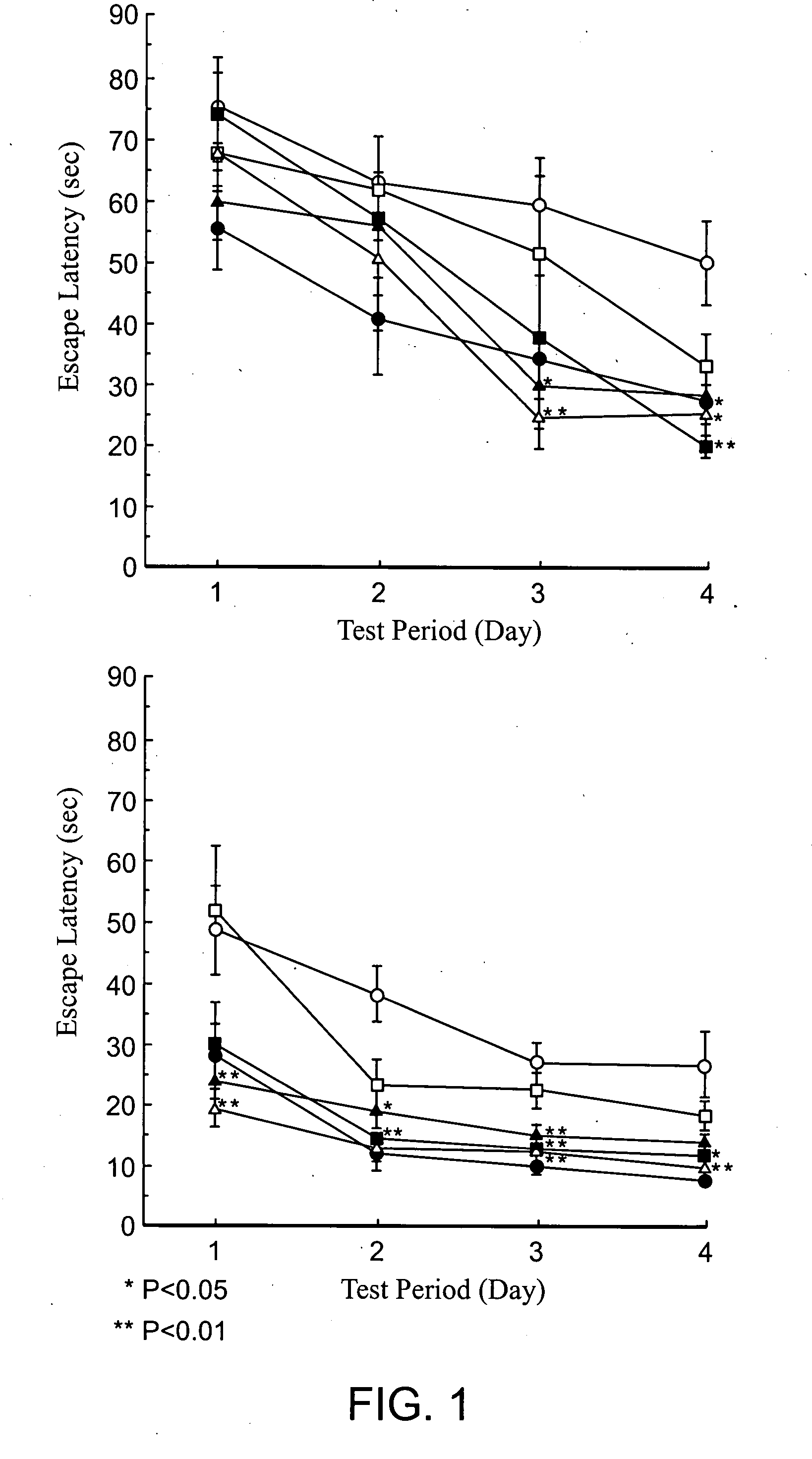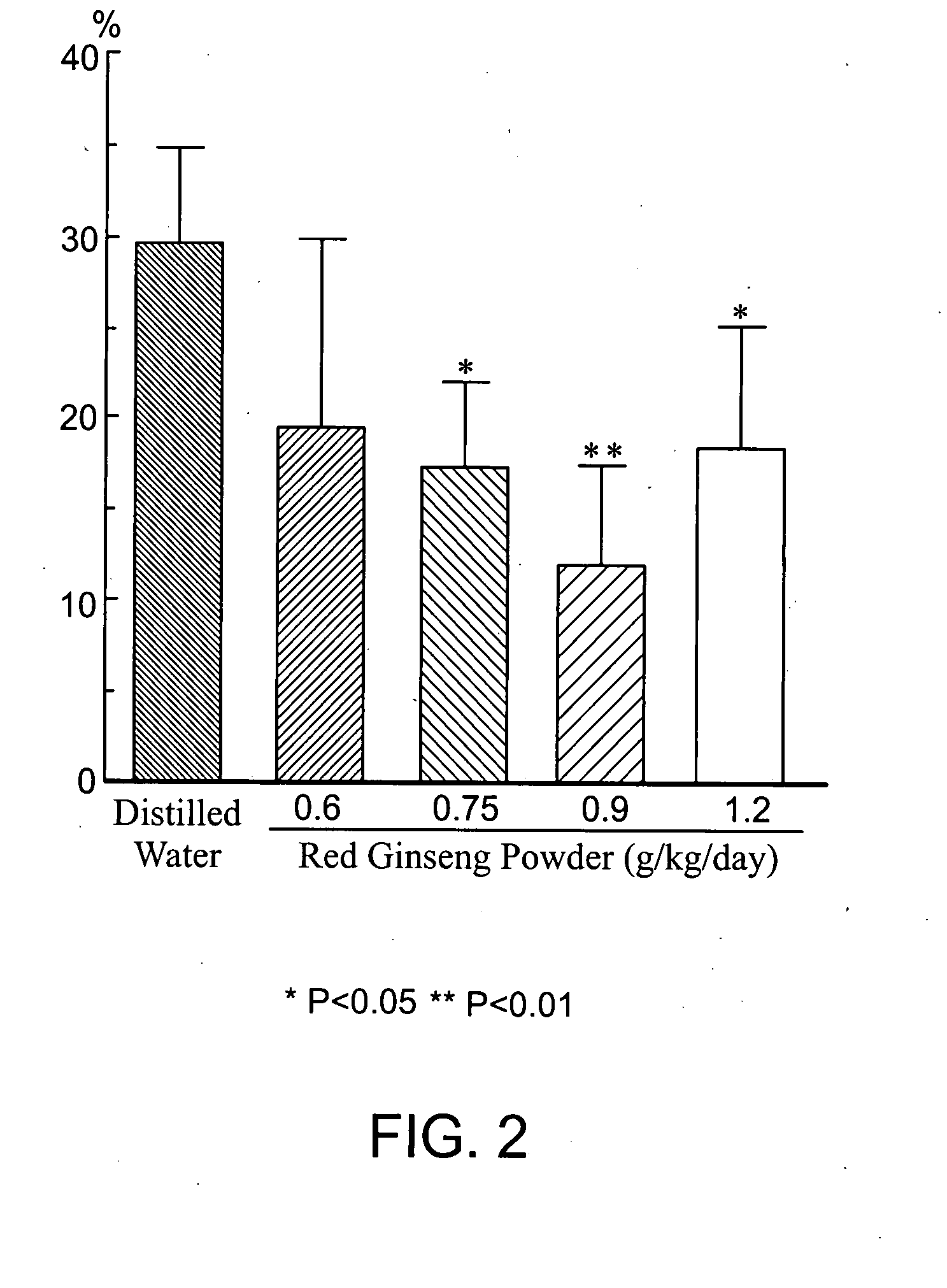Brain cell- or nerve cell-protecting agents comprising medicinal ginseng
a technology of brain cells or nerve cells and ginseng, which is applied in the field of medicinal ginseng, can solve the problems of inventing pharmaceutical compositions, difficult treatment of diseases, and long-term damage to patients' qol (life quality), and achieve excellent brain cell- or nerve cell-protecting effects, promoting expression of a cell death suppressing gene product bcl-xl protein, and preventing, treating and/or treating diseases.
- Summary
- Abstract
- Description
- Claims
- Application Information
AI Technical Summary
Benefits of technology
Problems solved by technology
Method used
Image
Examples
example 1
Experiment on Oral Administration of Red Ginseng Powder Before and After Cerebral Infarction
[0284] Male SH-SP rats at the age of 12-13 weeks, weighing 250-300 g, were used. Animals were bred in a room furnished with 12 hours light and dark cycles and water and feeds were supplied ad libitum. The cortical branch of the left middle cerebral artery (MCA) of each animal was coagulated and cut under inhalation anesthesia according to the method described by the present inventors (Sakanaka and Tanaka) (Igase, K., et al., J. Cereb. Blood Flow Metab., 19, 298-306, 1999; Sadamoto, Y., et al., Biochem. Biophys. Res. Commun., 253, 26-32, 1998). Red ginseng powder was mixed with distilled water and administered orally once a day for one week before MCA permanent occlusion and for 32 days after MCA permanent occlusion (0.6 g / kg / day, 0.75 g / kg / day, 0.9 g / kg / day or 1.2 g / kg / day, n=5-8)
[0285] Control animals with MCA permanent occlusion (ischemic control animals) and sham-operated animals were or...
example 2
Experiments on Oral Administration of Red Ginseng Powder After Cerebral Infarction
[0293] The cortical branch of the left middle cerebral artery (MCA) of each male SH-SP rat at the age of 12-13 weeks, weighing 250-300 g, was coagulated and cut under inhalation anesthesia, and red ginseng powder in a dose of 0.9 g / kg / day was administered orally once a day for 32 days (n=7). Control animals with permanent MCA occlusion (infarcted control animals; n=8), were administered with only distilled water.
[0294] After MCA permanent occlusion, according to the method of the inventors (Sakanaka and Tanaka) (Zhang B. et al., J. Stroke Cerebrovasc. Dis., 7, 1-9, 1998; Igase, K., et al., J. Cereb. Blood Flow Metab., 19, 298-306, 1999; Sadamoto, Y., et al., Biochem. Biophys. Res. Commun., 253, 26-32, 1998), water maze tests were performed for 4 days at the 2nd week and at the 4th week, respectively, and the place navigation abilities of SH-SP rats were determined.
[0295] Results are shown in FIG. 5....
example 3
Experiments for Analyzing Upregulation by Red Ginseng Powder at High Dose of Bcl-xL Protein Expression in Neural Tissues
[0299] Whether or not oral administration of red ginseng powder increases the expression of Bcl-xL protein was investigated by using the transient forebrain ischemic model of gerbils. In our previous report (Wen, T. -C., et al. , J. Exp. Med., 188, 635-649, 1998), the experimental system for investigation of Bcl-xL expression in the hippocampal CA1 field after transient forebrain ischemia has been established, and effects of oral administration of red ginseng powder were examined with the use of this system.
[0300] As shown in FIG. 7, one of the present inventors (Sakanaka) had reported that when red ginseng powder was administered orally in a dose of 0.9 g / kg / day or 1.5 g / kg / day, once a day for 7 days before transient forebrain ischemia for 5 minute in gerbils, nerve cell death in the hippocampal CA1 field was significantly prevented and the response latency time...
PUM
| Property | Measurement | Unit |
|---|---|---|
| temperature | aaaaa | aaaaa |
| occlusion time | aaaaa | aaaaa |
| body weight | aaaaa | aaaaa |
Abstract
Description
Claims
Application Information
 Login to View More
Login to View More - R&D
- Intellectual Property
- Life Sciences
- Materials
- Tech Scout
- Unparalleled Data Quality
- Higher Quality Content
- 60% Fewer Hallucinations
Browse by: Latest US Patents, China's latest patents, Technical Efficacy Thesaurus, Application Domain, Technology Topic, Popular Technical Reports.
© 2025 PatSnap. All rights reserved.Legal|Privacy policy|Modern Slavery Act Transparency Statement|Sitemap|About US| Contact US: help@patsnap.com



